Pruning and shaping lemon at home
Pruning homemade lemon is an important step in growing it. The correctness of the development of the tree, the attractiveness, timing and abundance of flowering and fruiting, the risks of infection with diseases and pests depend on how correctly and in a timely manner it will be performed.
The procedure has different goals: it is used to form a beautiful and neat crown, remove diseased and weak shoots, collect planting material, and stimulate the formation of new branches. Consider how and when to cut a lemon.
The content of the article
Is pruning indoor lemon a must
It is imperative to prune the indoor lemon tree. Without this procedure, it will not bear fruit, it will start to hurt.
The main goals of pruning:
- Increasing the attractiveness of the indoor plant. Without pruning, the lemon either grows upward with virtually no branches, or turns into a sprawling bush with weak shoots. In both cases, the plant looks untidy. With the help of pruning, it will be possible to form a beautiful crown of any shape, increasing the aesthetics of the lemon.
- Stimulation of fruiting... Without timely pinching and removing unnecessary branches, the lemon will waste energy on the development of existing shoots, without throwing out new ones. In this case, branches of the 4-6 order (it is on them that fruits are formed) may not appear at all. A tree with a thickened crown spends a lot of energy on the green mass, produces small and tasteless fruits, or even drops the ovaries.
- Prevention infection with diseases and the appearance of pests... When thickening in the crown, air circulation is disturbed. Such conditions are optimal for the development of fungal infections. Fungi and harmful insects often settle in damaged and weak shoots, which must be removed.
- Rejuvenation... Pruning prolongs the life and fruiting of the old tree.
- Improved fruit taste. Pruning lemon at home is good for fruiting. It improves the quality of fruits, increases their size. In the shaded crown, the fruits are small and sour. If you shape the green part so that the ovaries get enough sunlight, the lemons will accumulate more sugar, be larger and juicier.
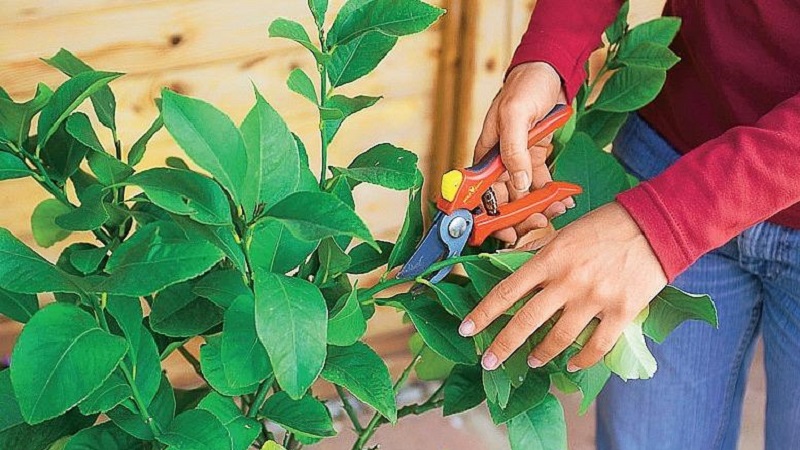
Pruning time
Citrus plants are pruned once a year... The first time the procedure is carried out in the first year of the plant's life, after the bole reaches 20 cm in height.
Most gardeners think the best time to cut lemon is in spring., first half of March. Usually, the procedure is carried out before flowering, but at home in a pot by this time the lemon can bloom. During spring work, the plant adapts more quickly, tolerates stress more easily, and gives rise to new shoots faster.
Some growers prefer to prune in winter., after removing the fruit. This usually occurs in February, before the start of sap flow. If the tree is at rest (does not bear fruit, stands in a cool room), the procedure is not recommended.
Attention! It is believed that lemon is allowed to form all year round. However, experienced gardeners do not recommend performing the procedure in the summer. They believe that the best period is from February to March.
Autumn pruning is also acceptable... In this case, work is carried out from the end of October to November.Most lovers of exotic plants in the fall prefer not to form, but to carry out sanitary removal of weak and damaged shoots.
When unscheduled pruning is needed
Citruses are pruned once a year. Thinning the crown more often will harm the plant.
The younger the tree, the greater the risk of death due to too frequent pinching..
there is cases in which carrying out trimming procedures more than 1 time per year is justified... Among them:
- Defeat by diseases. To save the plant, you have to act quickly. If possible, remove infected shoots to reduce the risk of infection on healthy branches.
- Severe pest infestation. Remove parts completely eaten by insects.
- Yellowing leaves, loss of turgor. Such signs indicate a violation of the rules of care or a disease of the plant. Often the only way to save citrus is to remove the dead branches and replant the lemon.
Formation
The formation of a lemon crown is an important step in care. Not only the appearance of the plant, but also its fruiting depends on the correctness of the procedure..
Peculiarities of citrus branching
To form a lemon correctly, it is important to understand the peculiarities of its branching.
This will help you understand which shoots to remove and which ones to leave:
- In the first year, only one shoot will grow, it is called a stem or trunk. This is a zero-order shoot on which skeletal branches are formed.
- Branches are formed on the trunk - shoots of the first order. This happens after the plant reaches one year of age. Leave 4-5 such branches.
- On the shoots of the first order, branches of the second order are formed. The growths of the third are formed on them. Next are the shoots of the fourth order, on them - the fifth, etc.
- Fruits are formed starting from the fourth order shoots.
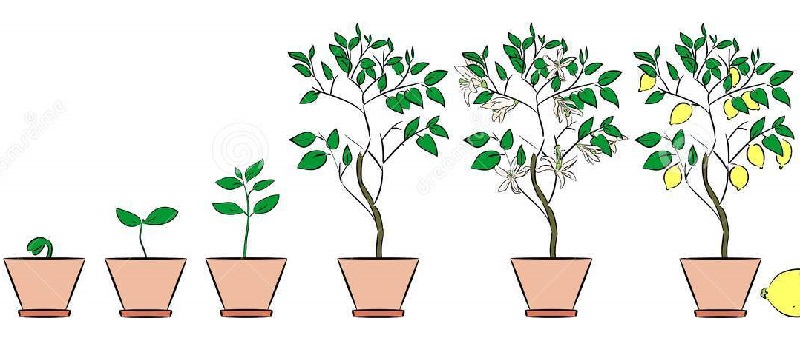
It is believed that branches of a new order grow every year.
Fundamental rules
Lemon is formed according to a number of rules:
- It is important to start pruning with zero shoot. The procedure will stimulate the formation of new branches.
- It is important to ensure that buds grow on several shoots at once. If some of the shoots do not throw out new shoots, the extra branches will have to be removed.
- Places of cuts are covered with garden pitch. It prevents the plant from infesting diseases and pests.
- Formation of a flat crown is better for citrus growing in a pot.
- Branches directed into the crown are removed or bent outward. It is recommended to direct them towards the windowsill. It is best to leave the branches pointing outward, outward and upward.
- When the crown reaches the size of the window connector, pinch the growth points. Otherwise, the plant will not have enough light.
- The first pruning is carried out only after the height of the zero shoot reaches 20 cm.
- Excess shoots are removed completely, leaving no hemp. They are pinched off as close to the trunk as possible.
- The necessary branches are pinched to the optimal length (usually after the formation of 5–7 leaves). The procedure stops the growth of branches at a suitable length.
Step-by-step instruction
Even beginner citrus growers will cope with the formation.
The main thing is to follow step by step instructions:
- The zero shoot is pinched when its height reaches 15–20 cm. After that, the growing point is pinched off. There should be 2–4 live buds on the stem.
- Shoots will grow from the buds on the trunk. They are bent in different directions. The pinching is carried out after the length of the branches reaches 20-30 cm.
- Shoots of the second order are oriented in different directions, pinched at a height of 20-25 cm. Branches directed inside the crown are completely removed. If there are few shoots, they are straightened out.
- The branches of the third and fourth order are pruned according to the same principle. Shoots of the new order should be 5 cm shorter than the previous ones.
- After the branches of the fourth order, the formation is stopped. Only a supporting pruning is carried out.
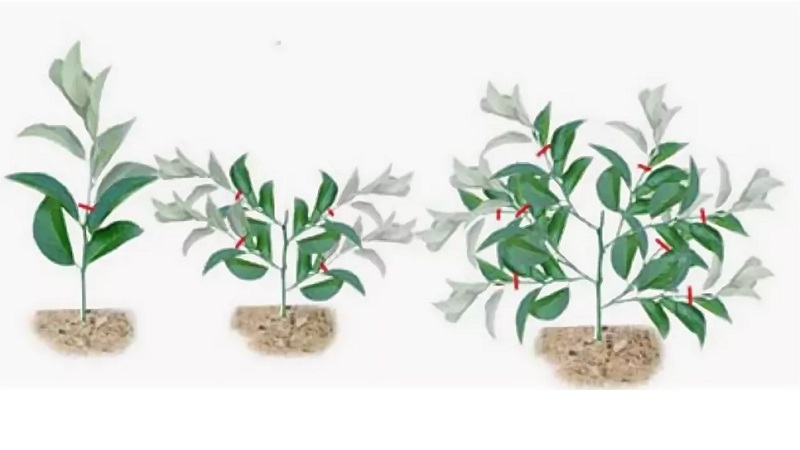
A pinch of lemon
Pinching differs from pruning in that the branches are not completely removed, but the growth point is destroyed, due to which the shoot is lengthened.It is cut off from thin branches with scissors, and from thick branches - with pruning shears.
Pruning involves shortening the shoot by 1/3 of the length or more... This stimulates the growth of lateral branches. Pinching implies a slight decrease in green mass.
Important! Before pinching, the tool is sharpened and disinfected with alcohol or a dark pink solution of potassium permanganate.
How to pinch a lemon correctly? With scissors or pruning shears, cut 2-3 cm from the top of the shoot together with the growth point. Usually remove the soft part with 1-2 leaves. The cut site is treated with garden pitch.
Pruning and fruiting
Don't expect the tree to bloom immediately after pruning. The crown is already well-branched, but the fruit branches are missing, the tree is stressed and not ready to bloom.
The first flowering and fruiting are possible only after the formation of branches of the 4th order... After their formation, the tree usually does not bloom, so the fruits appear at the 5th year of life.
With a large number of flowers and ovaries, citrus fruits are small, with low palatability. Often in this case, the tree drops all the fruits, and with excessively abundant fruiting, it does not form them at all the next year.
No more than 4 of the largest and strongest flowers are left on one shoot... The rest of the ovaries and flowers are pinched off. First of all, this is done with small and deformed specimens. Branches with a lot of small flowers can be cut out completely. This is also the case with shoots on which too many weak ovaries have formed.
In the first year, most of the ovaries are removed on the tree, leaving only 2-3 fruits... The next year, their number is increased by another couple of fruits. Then proceed according to the scheme described above.
Under these conditions citruses will turn out large and tasty, the tree will not throw them off... The lemon will have enough strength to develop a moderate amount of ovaries.
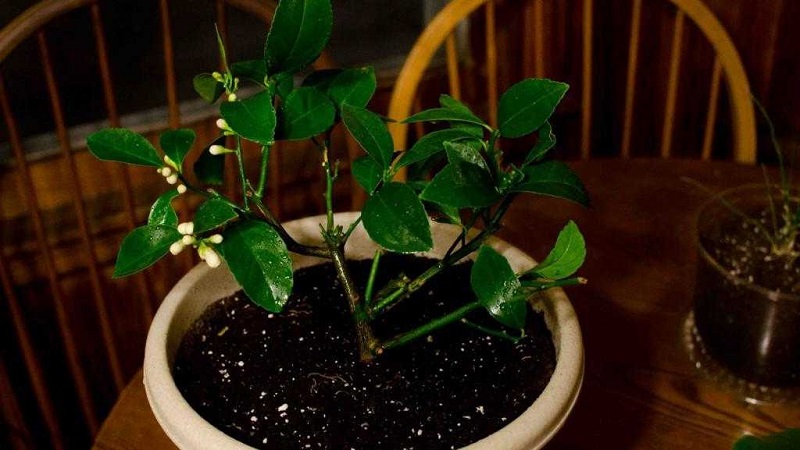
Anti-aging pruning
Anti-aging pruning it is used for old trees that give a minimum growth of young, poorly fruiting shoots... In this case, most of the branches are cut out. As a result, the tree begins to actively throw out new shoots.
For the first few years, it may not bear fruit at all, then fruiting will resume. The lifespan of the lemon tree will increase.
Anti-aging pruning aims to work with branches from order 3 and higher... Skeletal shoots of the 2nd and 3rd order do not touch. Only dried skeletal branches are cut.
Branches from the 5th order are cut completely... They are removed right down to the base of the trunk, leaving no stumps. The cut points are sanded with sandpaper and covered with garden varnish.
All dry, weak and old branches of the 4th order and below are removed... They are also cut at the base, glossing over the places of the cuts. The branches growing inside the crown are removed.
Attention! After anti-aging pruning, the tree looks bald. However, new shoots grow rapidly and the crown is restored.
After the procedure, it is important fertilize to stimulate the growth of green mass... It is better to use complex products with a high nitrogen content.
Sanitary pruning
When growing lemon, sanitary pruning is mandatory. It helps to avoid infection of the plant with diseases and attacks of pests... Pre-carefully examine the tree for signs of infection.
Remove all damaged, broken branches... Shoots with cracks in the bark are also cut off. If there are signs of damage on the branches, treatment is carried out. Severely affected parts are removed.
After sanitary pruning, preventive spraying is carried out a solution prepared from 3 liters of water and 1 tsp. copper sulfate.
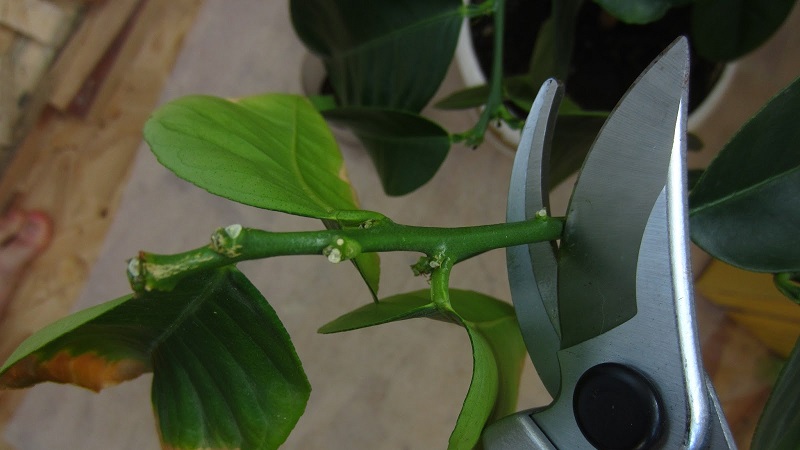
Harvesting cuttings for propagation
Lemon cuttings do not need to be cut specially. Planting and grafting material is also harvested during formation. To do this, they wait until the branches to be cut will be long enough to on a separate part there were 3-4 kidneys.
Extra shoots and branches directed inward are used as planting material.... Weak, dry and diseased shoots are not suitable.
Important! To prepare high-quality vegetative material, the plant is watered before pruning.
Sometimes lemon trees give little growth. In this case cuttings for planting will not be enough. To stimulate the formation of branches, prune all new fruit branches... This stimulates the rapid growth of green mass, but there will be no fruit in the current year.
Possible problems and tips
To make pruning more beneficial and successful, it is important to take into account some of the nuances:
- Removing excess flowers. Excessive flowering affects not only the quality and quantity of fruits, but also the development of the tree as a whole. If you do not pinch off excess inflorescences in time, the citrus will dry out within several years.
- Top dressing. A week before pruning or a week after, the tree is fertilized with nitrogen products. This will help the plant to endure stress more easily and stimulate the growth of green mass.
- Annual trimming works. If you skip them, fruiting will come later, the tree will not develop correctly.
- Cutting the crown. To give indoor citrus a more aesthetic look, they form a green mass with scissors, cutting off only the tops of the shoots. The procedure is allowed to be carried out all year round.
- Until the end of crown formation, the plant does not allow flowering, otherwise the yield will be low, growth will slow down, and the risk of plant death will increase.
- When forming, it is important to be careful and follow the instructions. The mistakes made will be difficult to correct.
- Excessive pruning stimulates the formation of new strong shoots. Pinching the tops awakens the fruit buds.
- Branches of the 5th order and higher are pinched after 5-7 leaves. This simulates flowering and ovary formation.
Sometimes, when forming a crown, the citrus grower faces difficulties.:
- In the place where 3 or 4 shoots appear, only 1 branch is formed. To remedy the situation, the branch is broken out. If the next growth again does not give the required number of shoots, the procedure is repeated.
- Tops are formed on the lemon - branches that grow vertically and increase in size faster than others. No fruits are formed on such processes. Experienced growers recommend cutting them under the base. Some citrus lovers do not remove the tops, but shorten them to 25 cm.

Care after pruning
After the procedure, be sure to coat the cuts... Use a garden pitch or other suitable remedy. It is not necessary to cover the places of the cuts of thin twigs.
After cutting, the lemon is placed in a shaded place for 2 weeks., protecting from direct sunlight. The room temperature should not exceed + 20 ° C. It is important to control humidity between 65% and 80%. When these indicators are exceeded, the risks of decay increase.
After the procedure, top dressing is applied... Complex fertilizers with nitrogen are used.
Conclusion
Lemon pruning is an essential step in caring for it. It depends on the regularity and correctness of the procedure whether the tree will bloom and bear fruit.
Timely removal of excess shoots increases resistance to diseases and pests, makes the crown more aesthetic, and extends the life of the plant.